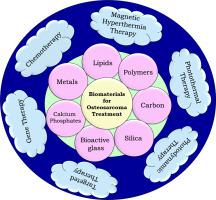Biomaterials Advances ( IF 5.5 ) Pub Date : 2021-01-14 , DOI: 10.1016/j.msec.2021.111875 Mural Quadros , Munira Momin , Gunjan Verma

|
Osteosarcoma is the most commonly diagnosed form of bone cancer. It is characterized by a high risk of developing lung metastasis as the disease progresses. Standard treatment includes combination of surgical intervention, chemotherapy and radiotherapy. However, the non-specificity of potent chemotherapeutic agents often leads to major side effects. In this review, we discuss the role of various classes of biomaterials, including both organic as well as inorganic in realizing the local and systemic delivery of therapeutic agents like drugs, radioisotopes and even gene silencing agents to treat osteosarcoma. Biomaterial assisted unconventional therapies such as targeted therapy, nanotherapy, magnetic hyperthermia, gene therapy, photothermal and photodynamic therapies are also being explored. A wide variety of biomaterials including lipids, carbon-based materials, polymers, silica, bioactive glass, hydroxyapatite and metals are designed as delivery systems with the desired loading efficiency, release profile, and on-demand delivery. Among others, liposomal carriers have attracted a great deal of attention due to their capability to encapsulate both hydrophobic and hydrophilic drugs. Polymeric systems have high drug loading efficiency and stability and can even be tailored to achieve desired size and physiochemical properties. Carbon-based systems can also be seen as an upcoming class of therapeutics with great potential in treating different types of cancer. Inorganic materials like silica nanoparticles have high drug payload owing to their mesoporous structure. On the other hand, ceramic materials like bioactive glass and hydroxyapatite not only act as excellent delivery vectors but also participate in osteo-regeneration activity. These multifunctional biomaterials are also being investigated for their theranostic abilities to monitor cancer ablation. This review systematically discusses the vast landscape of biomaterials along with their challenges and respective opportunities for osteosarcoma therapy.
中文翻译:

生物材料辅助治疗骨肉瘤的设计策略及其作用的演变
骨肉瘤是最常见的骨癌诊断形式。随着疾病的发展,其特征是发生肺转移的风险很高。标准治疗包括外科手术,化学疗法和放射疗法的结合。但是,有效化疗药物的非特异性通常会导致严重的副作用。在这篇综述中,我们讨论了各种生物材料的作用,包括有机和无机在实现局部和全身递送治疗剂(例如药物,放射性同位素甚至基因沉默剂)以治疗骨肉瘤中的作用。生物材料辅助的非常规疗法,如靶向疗法,纳米疗法,磁疗,基因疗法,光热疗法和光动力疗法也正在探索中。多种生物材料,包括脂质,碳基材料,聚合物,二氧化硅,生物活性玻璃,羟基磷灰石和金属被设计为具有所需装载效率,释放曲线和按需输送的输送系统。其中,脂质体载体由于能够包封疏水性和亲水性药物而备受关注。聚合物系统具有较高的载药效率和稳定性,甚至可以进行定制以实现所需的尺寸和理化性质。碳基系统也可以看作是即将到来的一类疗法,在治疗不同类型的癌症方面具有巨大的潜力。诸如二氧化硅纳米粒子的无机材料由于其介孔结构而具有较高的药物有效负载。另一方面,诸如生物活性玻璃和羟基磷灰石之类的陶瓷材料不仅充当了极好的传递载体,而且还参与了骨再生活动。还正在研究这些多功能生物材料的治疗诊断癌症消融能力。这篇综述系统地讨论了生物材料的广阔前景,以及它们在骨肉瘤治疗中所面临的挑战和机遇。











































 京公网安备 11010802027423号
京公网安备 11010802027423号